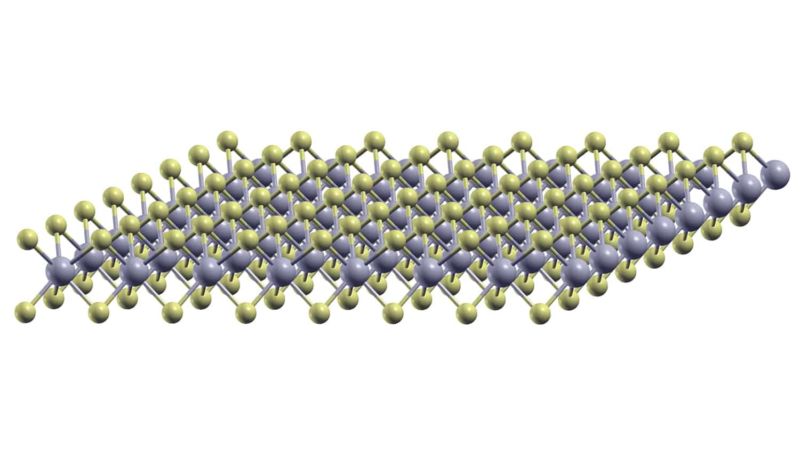
Graphene may seem like a modern wonder-material, but it has been with us for ages in the form of graphite. Graphene is a sheet of carbon atoms bonded to each other, just one atom thick; graphite is just an agglomeration of these sheets layered on top of each other. To study graphene, however, it took someone clever to devise a way of peeling single layers off from this agglomeration (the secret turned out to be a piece of tape).
Since then, we've identified a handful of additional chemicals that form sheets that are a few atoms thick. These have a variety of properties—some are semiconductors and have been combined with graphene to make electronic devices. To expand the range of devices we can craft that build on the advantages of these atomically thin materials, a larger catalog of chemicals like this would be handy.
Now, a Lithuanian-Swiss team says it has done just that. The team has found materials just like graphite: a bulk material with atomically thin layers hidden inside.
The work relies heavily on other scientists having shared their data in open repositories. These include large databases that hold the structure of crystals for a huge number of chemicals. The Inorganic Crystal Structure Database, for example, held nearly 100,000 unique crystal structures when this research was performed; the Crystallography Open Database another 90,000. Each of these structures provides the details of how the atoms of a material are arranged in three-dimensional space. Almost all of these materials, however, are 3D, with a repeating pattern of atoms extending to the edges of the material in all directions.
Not your typical database search
The authors developed computer code that could search through the structures for something like graphite. Graphite has strong chemical bonds among the carbon atoms of each layer. But the layers are held together by a relatively weak electrostatic interaction called a van der Waals force. While the van der Waals forces are enough to hold the material together under most conditions, they're weak enough to allow individual layers to be peeled off the bulk graphite.
So the authors' new software searched for something similar: strong chemical bonds along one plane and a relatively weak non-chemical interaction in a perpendicular one. This narrowed things down dramatically, leaving the team with a bit over 5,500 chemicals to consider. The team then used other software to calculate the strength of the attraction between adjacent sheets in the material. If this attraction is too strong, a layer will probably break instead of flaking or peeling off. While this eliminated a number of chemicals from the authors' search, there were still more than 1,800 left.
In many cases, the materials were structurally similar in terms of the locations of the atoms and the chemical bonds among them. For example, molybdenum disulfide is a well-studied example of an atomically thin material, but the authors identified 13 additional chemicals that form similar structures. Another structure, exemplified by cadmium di-indide, showed up in 64 different chemicals in total. While many of these sheets would end up being similar in behavior, the different atoms involved raise the possibility that some will end up being quite distinct. And a few of the structures had never been described before.
Tracking electrons
To figure out what sorts of materials we could add to our arsenal, the researchers calculated what the electrons would be doing in 258 of the less-complex chemicals. Most of them (166) turned out to be semiconductors, although the voltage difference between their ground and conducting states ranged from zero to 1.5 electronVolts. Another 92 materials were metallic. Another 56 are likely to have unusual magnetic properties, and a few others are likely to have behaviors that depend on an electron's spin, like a half-metal.
Now, it's not clear how many of these materials will actually be easy to make and then flake off into atomically thin sheets. But even if only 10 percent of the original collection work out, that's still a big leap forward. The large number of distinct properties in this collection of materials raises the prospect of having the ability to choose one that's appropriate for specific applications.
In addition, it opens up the possibility for the layering of these atomically thin materials. Because they're so thin, dropping one sheet on top of another will change the properties of both, in part depending on how the atoms line up next to each other. Lots of different materials means lots of potential to tweak this alignment. So, while this paper distills down to a very elaborate database search, I'm excited to see what happens as researchers begin testing some of the materials their research has identified.
Nature Nanotechnology, 2017. DOI: 10.1038/s41565-017-0035-5 (About DOIs).
reader comments
49